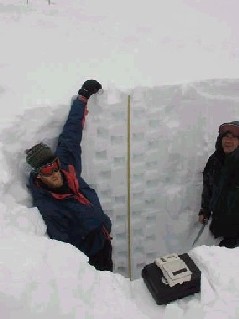Gus Goodbody and John Fitzgerald are standing in a snow pit checking snow density high within Colorado’s Rocky Mountains. The snow depth is about 2.2 meters.
Click on image for full size
Courtesy of CLPX NASA Land Surface Hydrology Program
Super Scientists Study Snow!
News story originally written on February 21, 2003
Snow is fun! It can be made into snowballs or snow angels. It can even cause school to be cancelled. Many scientists think that snow is pretty interesting too.
This week, scientists and college students began a project to look at the snow that is in Colorado’s Rocky Mountains. They are looking at it from many different places - from the ground, from in the air, and even from space!
In some places on Earth, water is frozen during the cold winter months. In other places, water is frozen all year long! The scientists hope to better understand the areas on Earth where there is frozen water. Keeping track of the amount of snow can help scientists figure out how much water cities and towns will have in the spring as the snow melts. They could also predict if melting snow will cause spring floods.
The scientists will look for the best way to study snow from space. NASA satellites will look at the snow from above with sensors. Hopefully, their research will help make the sensors better so that someday we can look from space to measure the amount of snow around the world!
Last modified February 24, 2003 by Lisa Gardiner.
You might also be interested in:

It was another exciting and frustrating year for the space science program. It seemed that every step forward led to one backwards. Either way, NASA led the way to a great century of discovery. Unfortunately,
...more
The Space Shuttle Discovery lifted off from Kennedy Space Center on October 29th at 2:19 p.m. EST. The sky was clear and the weather was great. This was the America's 123rd manned space mission. A huge
...more
Scientists found a satellite orbiting the asteroid, Eugenia. This is the second one ever! A special telescope allows scientists to look through Earth's atmosphere. The first satellite found was Dactyl.
...more
The United States wants Russia to put the service module in orbit! The module is part of the International Space Station. It was supposed to be in space over 2 years ago. Russia just sent supplies to the
...more
A coronal mass ejection (CME) happened on the Sun last month. The material that was thrown out from this explosion passed the ACE spacecraft. ACE measured some exciting things as the CME material passed
...more
Trees and plants are a very important part of this Earth. Trees and plants are nature's air conditioning because they help keep our Earth cool. On a summer day, walking bare-foot on the sidewalk burns,
...more
There is something special happening in the night sky. Through mid-May, you will be able to see five planets at the same time! This doesn't happen very often, so you won't want to miss this. Use the links
...more















